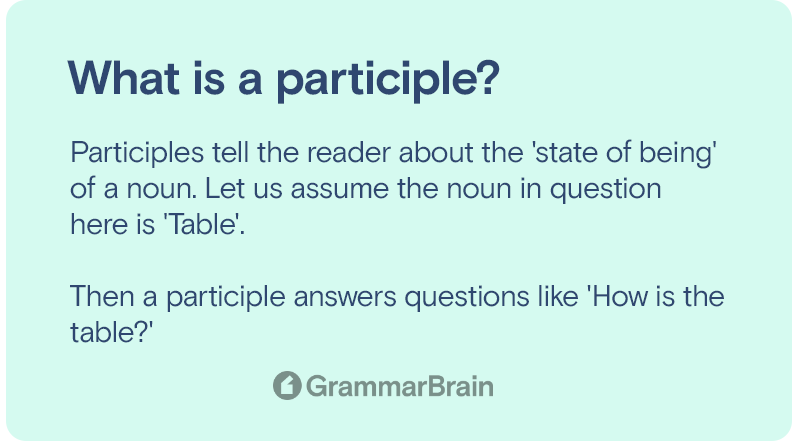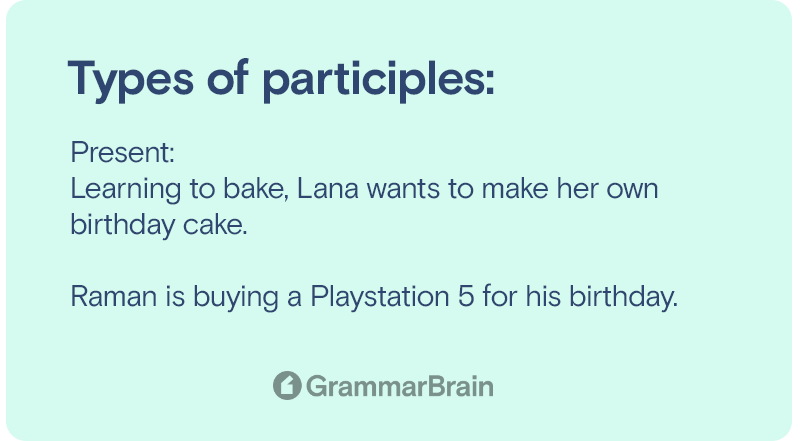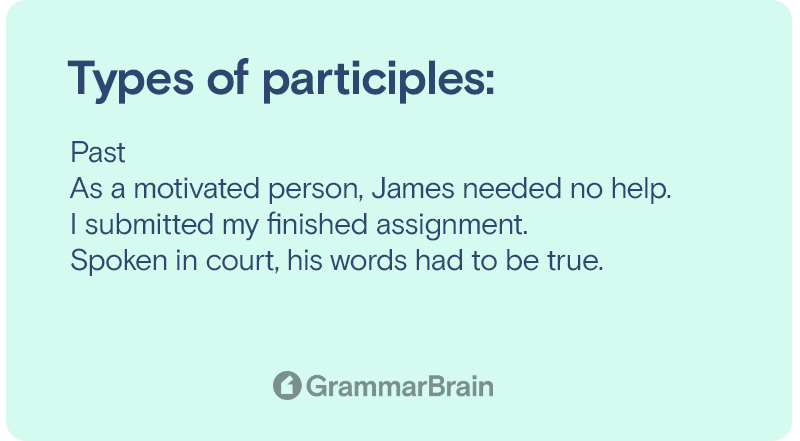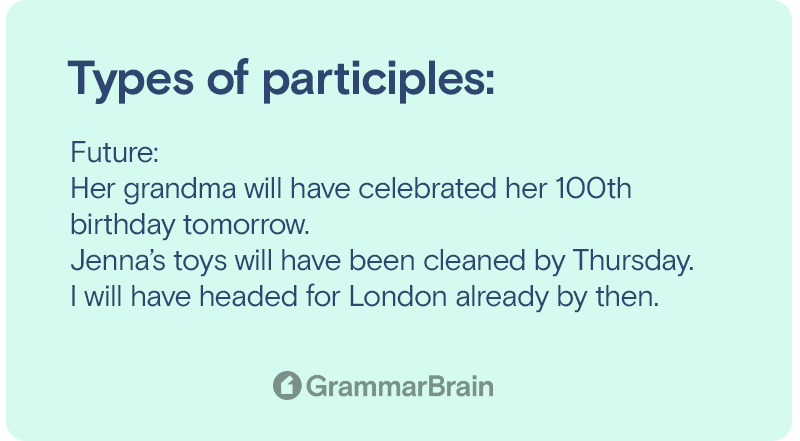What is a participle? And how does it change the words that we use? And the sentences that we form? These are great questions. Participles help us describe when and how things are occurring. They help us say that something occurred in the past, present, or will happen in the future.

What are Participles?
Participles are a form of verb. But instead of using them traditionally to just describe an action, they are also used to describe other nouns. They are non-finite in nature, which means that they cannot describe action as the sole root of an independent clause.
For example, painted nails. Paint is a verb, and nails is a noun. But ‘painted nails’ is used to describe the condition of the noun (aka nails) in this case.
What do participles do?
Participles tell the reader about the ‘state of being’ of a noun. Let us assume the noun in question here is ‘Table’.
Then a participle answers questions like ‘How is the table?’, or ‘What is the current state of the table?’ using action words.
For example: A polished table.
Polish is a verb and table is a noun. The verb here is answering the question ‘What is the current state of the table?’- ‘It is polished’.
Why do we need participles?
Reason 1: To describe the ‘state of being’ of a noun
Participles are needed to add to the description of the subject. Then you might ask,’ Well, that is what adjectives are for ‘. And you would be correct. But adjectives are just visual, sonic, or sensory descriptions of a noun. For example,‘ A beautiful rose’, or ‘The constant rain’, etc.
Here, the words beautiful and constant refer to sensory descriptions of the noun in question, where they tell you more about what the noun might seem to you. They are not action words.
But to talk about a ‘state of being’ of the rose or rain, you will need an action word. For instance, you will say, ‘A chopped rose’, or ‘The pouring rain’. Here chopped and pouring are both action words.
Reason 2: To act as a bridge between auxiliary verbs to create a tense
A participle can also act as a connecting word to signal the tense in which the action is happening.
‘Harry is running for president of the school club’
Even though the word is a verb, it describes the state of Harry’s action and indicates whether it is happing in the present, past or continuous tense. In this case, the participle is in the present continuous tense.

Grammar rules for using participles:
Rules of using a participle are the following: Participle+Noun. (or even Noun+Participle)
Even though it might seem very straightforward, the combination is tense-sensitive. What does that mean?
If the sentence is happening in the present tense, then you use the present tense of that verb.
For instance, ‘The crying baby kept everyone awake on the flight’.
Where is the participle in this case?
‘crying’ is the participle that tells us more about the state of the noun,’ baby’. ‘Crying’ is the present continuous version of the verb ‘cry’ because it tells us about the continuous nature of the action word.
Whereas, if we used a different example like, ‘The damaged bicycle was taken for repair’, the participle ‘damaged’ has to be written in the past tense of the verb ‘damage’. Because the sentence takes place in the past.
It can also be written as a part of a longer phrase.
For instance, ‘Jumping on the plane, the passenger gave everyone a scare.’ Here, the participle is ‘jumping’. But the accompanying noun doesn’t show up until the end of the phrase.
Similarly, the participle can appear after the noun too.
Mia was doing her homework. Here, the participle comes after the noun (Mia).
Types of participles:
There happen to be three types of participles:
- Present Participle
- Past Participle
- Perfect Participle

1. Present Participle:
Present participles talk about the descriptive action in the present tense.
For instance:
a. Learning to bake, Lana wants to make her own birthday cake.
b. Raman is buying a Playstation 5 for his birthday.
c. Playing with his plane, the child is enjoying the park.
You will notice here that in the final example, there are two Present Participles, one before the noun (child) and one after. Both the participles, in this case, are in the present tense and describe the action being done by the child. Both ‘playing’ and ‘enjoying’ are present continuous tenses of the verbs ‘play’ and ‘enjoy’.
Grammar Rules:
In the present participle, you can add an -ing to your verb to signify its occurrence in the present tense. For instance,
‘ Removing his coat, Mana goes straight for the dive’
Remove is a verb that describes the action of removing. Adding in -ing, in the end, shows that the action is happing in the present tense.
More examples:
- Writing his name, Jonah left the paper on the counter.
- The teacher is typing out the grades of her students.
- I am eating a bagel.
- We are seeing a hike in the city’s population lately
Present Continuous:
Continuous form is used on a present participle when the action is taking place in real-time. Any descriptive action word that is currently happening has to be written in a present continuous form.
This participle can be placed in two positions with regard to the noun in the sentence:
1. After the noun
Example:
- George is coming home soon.
- The people are cutting wood.
- The squirrel is climbing a tree.
Along with the -ing verb, the word is preceded by a tense-indicating auxiliary verb like ‘am’, ‘is’, ‘are’, etc.
2. Before the noun
Example:
- Leaning on the railing, the girl is posing for a picture.
- Eating the pudding, the boy gestures to the waiter
- Putting on her wig, the woman is ready to leave.
Past Continuous:
Past continuous is a form used to indicate the state of continuity in a past action. This too can be written either before or after the noun.
For instance:
- The clerk was working day and night.
- Doing everything she could, Dany managed to escape.
- Keeping his business clean, the trader escaped jail.
There are two ways of writing a past continuous participle correctly:
1. Add a ‘was’ or ‘were’ before the -ing verb.
2. Add an -ed in the verb after, to indicate that the continuous action was happening in the past.
Future Continuous:
Future Continuous is a form used to indicate an ongoing action in the future. The way to write a future continuous form correctly is to add a ‘will/would’ + ‘be’ before the -ing verb. You could also replace will/would with shall/should.
The difference between a will and a shall is a matter of conviction. If someone says they ‘Will’ do something, it is more likely that the action verb in the sentence is certain to take place. But, if someone says they ‘Shall’ do something, the action verb in the sentence may or may not be executed.
But it is important to note that this changes completely when the other forms of the future auxiliary verbs are used. If someone said they ‘should’ doing something, it signifies more certainty behind the intent of that action. Whereas, if someone said they ‘would’ do something, the action may or may not be executed in the future.
For instance:
- Daniel will be competing for the trophy
- They would be coming to the concert
- You should be finishing your homework on time
- The Celtics shall be winning the game.
Using the present, past, and future tenses in the continuous form:
While adding an -ing to a verb, be mindful of a few rules:
General rule:
For most words, adding an -ing, in the end, is the correct form of writing it.
Example:
- Verb: Do; Continuous form: Doing
The father is doing enough work to keep his job.
- Verb: Go; Continuous form: Going
I am going to the game on Friday.
For verbs that end with an –e:
For most words that end with an –e, the correct way to convert it into its continuous variant is to remove the –e while adding the –ing.
Example:
- Verb: Debate; Continuous form: Debating.
The parliamentarians were debating the new bill.
- Verb: Escape; Continuous form: Escaping
The escaping criminal was caught by the police.
However, ensure that the verb does not end with a –ee (double e). If so, the continuous form of the verb just adds an –ing at the end.
Example:
- Verb: Flee Continuous form: Fleeing.
The thieves were fleeing the museum at night.
- Verb: See; Continuous form: Seeing
Seeing the child’s happiness, the mother bought the toy.
For verbs that end with an –ie:
For most words that end with an –ie, the correct way to convert it into its continuous variant is to add a –y while adding the –ing.
Example:
- Verb: Die Continuous form: Dying.
The plants are dying due to a lack of sunlight.
- Verb: Lie; Continuous form: Lying
The child was lying to his mother.
For verbs that end with a -c:
For most words that end with a –c, the correct way to convert it into its continuous variant is to add a –ck while adding the –ing.
Example:
- Verb: Panic Continuous form: Panicking
John began panicking way before the alarms went off.
- Verb: Picnic; Continuous form: Picnicking
The students are picnicking at the park.

2. Past Participle:
Past Participles, like Present Participles, are verbs (or action words) that describe a noun in a state that was in the past. Hence, they can be used as action adjectives, or can also be used in the perfect tense.
Example:
- As a motivated person, James needed no help.
- I submitted my finished assignment.
- Spoken in court, his words had to be true.
Usage of Past Participle:
- As an adjective for a noun:
Written exam papers need not be uploaded online.
Here, the noun being described is ‘exam papers’. And the past participle is the past tense of the verb ‘write’ (written). When used before the noun, the simple past form of the verb (wrote) does not apply. Hence, when used before the noun, ensure that you use the past participle form and not the simple past tense.
- To write sentences with modal verbs in the past tense:
Mary would have won the race yesterday.
Past participles can be used in conjuncture with modal verbs like will/would, shall/should, may/must, etc. The format for writing such a sentence would be:
(Modal verb)+(have)+(past participle).
- After an auxiliary verb in the past tense (was/were):
They were stopped by the traffic police for speeding.
In this case, auxiliary verbs (was/were) must be used before the past participle verb, where the verb (stop) has to be written in the past tense form (stopped).
- Used with direct objects to indicate a demand:
The supervisor wants the job completed by Friday
In this usage, the sentence structure follows the following format:
(want/have/like)+(noun)+(past participle)
Example: I like my pancakes cooked all the way through.
-where the noun is ‘pancakes’ and the participle is the past tense of the verb ‘cook’ (cooked).
- To subvert the usual passive phrase construction
He came in, accompanied by twelve other boys.
The usual passive phrase construction goes like this: (subject)+(passive verb).
In this case, the format is subverted by using the past tense of the verb in the format:
Subject (she)+active verb (came in)+passive verb in the past tense (accompanied)
- In the perfect tense to form past perfect participles
By the time she arrived, he had left.
The rule for using a part participle in the perfect tense is:
(had)+(past participle verb)
Example: I had left the building after class.
Here, ‘left’ is the past form of the verb ‘leave’, which comes after the auxiliary verb (had).
Converting verbs into their past participle form:
Verbs ending with –e:
For verbs that end with –e, just add –d at the end to get the past participle form of the verb.
Example:
- Verb: Accelerate Past form: Accelerated
Driving ahead, the car accelerated past the traffic lights.
- Verb: Ace; Past form: Aced
The student aced her evaluation.
Exception:
There are verbs that have regular past tense as well as a different participle form. Here, even though the verb ends with an –e, the past participle form ends with –n instead of –d.
| Verb | Past tense | Past Participle |
| Bite | Bit | Bitten |
| Take | Took | Taken |
| Write | Wrote | Written |
| Choose | Chose | Chosen |
| Drive | Drove | Driven |
| See | Saw | Seen |
Unfortunately, you have to memorize each of these verbs as they do not follow an overarching set of rules. These verbs are called irregular past participles, as they do not end with an –ed or a –d. The best way to develop an intuition for irregular past participles is to hear/read sentences where they are used.
Verbs ending with –y (where the preceding letter is a consonant)
For verbs that end with a consonant and –y, the past participle form of that verb ends with –ied
Example:
- Verb: pay; Past form: paid
Sheila paid the shopkeeper five dollars.
- Verb: deny; Past form: denied
He was denied entry into the building.
Verbs that end with –c:
For verbs that end with a –c, the past participle form of that verb ends with –cked.
Example:
- Verb: frolic; Past form: frolicked
The fairy frolicked around the yard.
- Verb: traffic; Past form: trafficked
The animal had been trafficked from a shelter.
Verbs that end with a vowel and a consonant:
For verbs that end with a vowel before a consonant, the past participle form of that verb ends with –(double vowel)+ed
Example:
- Verb: grab; Past form: grabbed
Little Thomas grabbed the candy with his tiny fists.
- Verb: stir; Past form: stirred
The woman stirred the glass of milk.
Exception: If a word ends in a vowel and a consonant, but the second of the two syllables is not pronounced as vividly, you must not double the vowel.
Example:
- Verb: rain; Past form: rained
It rained heavily this afternoon
- Verb: control; Past form: controlled
The pilot controlled the plane with great skill.
- Verb: open; Past form: opened
I opened a can of tuna.

3. Perfect Participle:
Perfect participles are used when you wish to indicate an action that occurred before the timeline of the main clause.
Having finished my breakfast, I was now ready to head to work.
Here, the phrase ‘having finished my breakfast’ indicates the reason why ‘I’ was ready to head to work.
Just like past participles, perfect participles can be written in both active and passive voices:
| Active voice (perfect participle phrase) | Passive voice (perfect participle phrase) |
| Having+past participle+object (not compulsory)+main clause | Having+been+past participle+object (not compulsory)+main clause |
| Example: Having seen the scores of her team, Danny was motivated. | Example: Having been the biggest fighter in the UFC, he was expected to win the finals. |
There are three forms of the perfect participle:
Present Perfect Participle:
Rule: (has/have)+(past participle)
Example:
- I have eaten dinner.
- The jury has ruled in her favor.
- Jonathan has taken his medication.
Past Perfect Participle:
Rule: (had)+(been(optional))+(past participle)
Example:
- They had taken every measure they could.
- The cops had patrolled the city.
- Your name had been removed from the list.
Future Perfect Participle:
Rule: (will/would)+(have)+(been(optional))+(past participle)
Example:
- Her grandma will have celebrated her 100th birthday tomorrow.
- Jenna’s toys will have been cleaned by Thursday.
- I will have headed for London already by then.
FAQs
What is a participial phrase and how to use it?
Participial phrases are used to indicate the state of the main clause or subject. The phrase usually begins with a participle and continues throughout a span of about 3-4 words to describe the noun. If the phrase appears before the main clause (or at the very start of the sentence), use a comma to separate the two. If not, you do not need a comma.
- Joining in on the radio, the guest began her musical performance.
- Taking all the precautions they could, the firefighters entered the building.
- I wished to talk to the lady dancing in red shoes.
What are dangling participles, and how to avoid them?
Dangling participles are descriptive verbs that describe the wrong subject, or are misplaced in their position with regard to the main clause.
There are usually two reasons for this:
- 1) The description comes a long time after the subject has been mentioned:
Example: The staff presented a service to their customer that was sub-par.
Notice here that there is a lot of distance between the subject (service) and the description (sub-par). This makes it seem that the customer was sub-par, instead of the service. This mistake is also called a ‘distant modifier’
Correct sentence: The staff presented a service that was sub-par to the customer.
- 2) Missing subject:
Example: Working in the lab, the chemical was spilled.
Here, as there exists a lack of subject, the sentence seems unclear.
Correct sentence: Working in the lab, she spilled the chemical.
Or As she was working in the lab, she spilled the chemical.
You could repeat the subject twice for clarity, and it would not affect the structure of the sentence.
Can participle phrases be present participles?
Yes, for example, “thinking quickly.” This is a participle phrase that is in the present participle verb form.
How are irregular verbs part of the equation?
Irregular verbs form words like “brought” and “rung.” Coming from the words “bring and ring.”
Inside this article
Fact checked:
Content is rigorously reviewed by a team of qualified and experienced fact checkers. Fact checkers review articles for factual accuracy, relevance, and timeliness. Learn more.
Core lessons
Glossary
- Abstract Noun
- Accusative Case
- Anecdote
- Antonym
- Active Sentence
- Adverb
- Adjective
- Allegory
- Alliteration
- Adjective Clause
- Adjective Phrase
- Ampersand
- Anastrophe
- Adverbial Clause
- Appositive Phrase
- Clause
- Compound Adjective
- Complex Sentence
- Compound Words
- Compound Predicate
- Common Noun
- Comparative Adjective
- Comparative and Superlative
- Compound Noun
- Compound Subject
- Compound Sentence
- Copular Verb
- Collective Noun
- Colloquialism
- Conciseness
- Consonance
- Conditional
- Concrete Noun
- Conjunction
- Conjugation
- Conditional Sentence
- Comma Splice
- Correlative Conjunction
- Coordinating Conjunction
- Coordinate Adjective
- Cumulative Adjective
- Dative Case
- Determiner
- Declarative Sentence
- Declarative Statement
- Direct Object Pronoun
- Direct Object
- Diction
- Diphthong
- Dangling Modifier
- Demonstrative Pronoun
- Demonstrative Adjective
- Direct Characterization
- Definite Article
- Doublespeak
- False Dilemma Fallacy
- Future Perfect Progressive
- Future Simple
- Future Perfect Continuous
- Future Perfect
- First Conditional
- Irregular Adjective
- Irregular Verb
- Imperative Sentence
- Indefinite Article
- Intransitive Verb
- Introductory Phrase
- Indefinite Pronoun
- Indirect Characterization
- Interrogative Sentence
- Intensive Pronoun
- Inanimate Object
- Indefinite Tense
- Infinitive Phrase
- Interjection
- Intensifier
- Infinitive
- Indicative Mood
- Participle
- Parallelism
- Prepositional Phrase
- Past Simple Tense
- Past Continuous Tense
- Past Perfect Tense
- Past Progressive Tense
- Present Simple Tense
- Present Perfect Tense
- Personal Pronoun
- Personification
- Persuasive Writing
- Parallel Structure
- Phrasal Verb
- Predicate Adjective
- Predicate Nominative
- Phonetic Language
- Plural Noun
- Punctuation
- Punctuation Marks
- Preposition
- Preposition of Place
- Parts of Speech
- Possessive Adjective
- Possessive Determiner
- Possessive Case
- Possessive Noun
- Proper Adjective
- Proper Noun
- Present Participle
- Prefix
- Predicate



